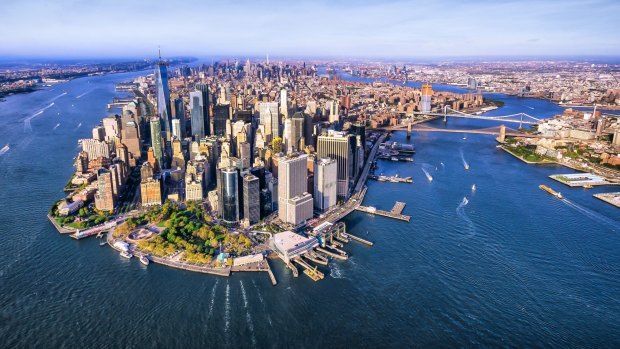This was published 3 years ago
Travel to the US from Australia during COVID-19: Five reasons it's the best place to go

New York has one of the highest vaccination rates in the US.Credit: iStock
As Omicron continues its march across the globe and countries implement restrictions that will affect your travel plans, there's one country that's actually still easy to travel in. With border measures making Europe a difficult destination for Australian travellers, here are five reasons to consider a visit to the country once considered COVID-central.
YOUR VACCINATION CARD WORKS HERE
In Europe, your international vaccination certificate isn't valid in many places. You'll need to access a Digital COVID Certificate on arrival, because Australia didn't join 28 non-European Union countries and territories who ensured their vaccination cards do work there (New Zealand did - c'mon Australia). Travellers have reported delays applying for their digital certificate and they can't enter restaurants, cafes, or attractions until they get it (TV watching in your hotel room probably wasn't high on your hit list, right?).
That's not the case in the US. Just get a copy of your international vaccination certificate (you'll need it to fly anyway) from your Medicare account on MyGov and you can get in anywhere you like. In fact, when I forgot mine, I used my Australian digital vaccine certificate on my phone and everyone accepted it.
ONCE YOU'RE IN, YOU'RE IN
Travelling in Europe right now is an exercise in pre-trip planning. You might be able to get into France today, but how about next week? And Portugal, for instance, requires travellers without a booster to show a negative COVID test or recovery certificate to get into restaurants. But will that change tomorrow? Once you're in the US, there's no more checks and measures. You'll just need a negative PCR test no more than 24 hours before you fly to get in, and you have a ticket to ride anywhere you want within its 50 states (and hey: why not try Alaska, or Hawaii). You'll have almost 10 million square kilometres to travel in. Compare that to Western Europe's largest country, France, at half a million square kilometres.
IF YOU TEST POSITIVE, YOU'LL ONLY HAVE TO ISOLATE FOR FIVE DAYS AND TESTING IS EASY
The US just shortened the recommended time for isolating for those with COVID. If you get COVID you're advised to isolate for five days. If after that time you're asymptomatic or your symptoms are resolving, you're told to follow this up with five days of wearing a mask. The Centers For Disease Control and Prevention in the US say the change is because the majority of transmission occurs early in the course of illness – that's one to two days prior to the onset of symptoms, and two to three days after.
Just as importantly, testing is easy here (as is getting a booster, if required). Free-of-charge COVID testing clinics are set up all across the country, many of which don't require you book ahead. Every major pharmacy also does testing (and booster shots). Results for rapid antigen tests generally come back within a few hours, while PCR tests will come back within 24 hours. If you choose to pay (anything from $US90 to $US450), PCR tests will come back within the hour.
OMICRON HAS PEAKED
Like Australia, a lot of people in the US got an unexpected Christmas present from Santa. I did: headaches, fatigue and night sweats. Omicron infection rates went crazy, with major tourist centres such as New York City, Washington DC and Los Angeles recording the highest amount of cases.
But just like South Africa, the US's infection rates peaked and have now dipped substantially. Infection rates remain higher in regions dominated by unvaccinated populations like those in North Dakota and Alabama, but cities like NYC and Washington DC in the country's north-east have infection rates falling dramatically.
A lot of people have already been infected and recovered. In Chicago everyone I know had it over Christmas and New Year's Eve. Omicron has been responsible for the tallest, sharpest spikes of infection of any variant, it hit hard at holiday time when everyone was travelling or socialising, but now cases are down 36 per cent from mid-January.
Infection and hospitalisation rates will continue in those places with low vaccination rates (and remember: 80 million Americans refuse the jab), but come late February, experts expect the US's infection rates to mirror South Africa (an 85 per cent drop in infections since mid-December) and the UK (a 50 per cent drop since late December).
THE VACCINATION RATE IS HIGH IN THE POPULAR PARTS
Don't let the TV news put you off, yes, there are a lot of people in West Texas and Alabama who refuse to get vaccinated – and the vaccination rate across the whole country is only 70 per cent (compared to 82 per cent in Australia), but it will be different story in the places most Australians want to go.
Most of our most favourite US destinations have vaccination rates currently set at around the same level as Australia's. New York City, for instance, has an 88 per cent vaccination rate, while ski resorts - like Aspen, Park City and Jackson Hole – have vaccination rates above 90 per cent. Over 80 per cent of Los Angeles is vaccinated, as is Chicago and those looking towards San Francisco can rest easy: 84 per cent of the population there are vaccinated. Hawaii's vaccination rate is even higher than these cities.
Sign up for the Traveller Deals newsletter
Get exclusive travel deals delivered straight to your inbox. Sign up now.

